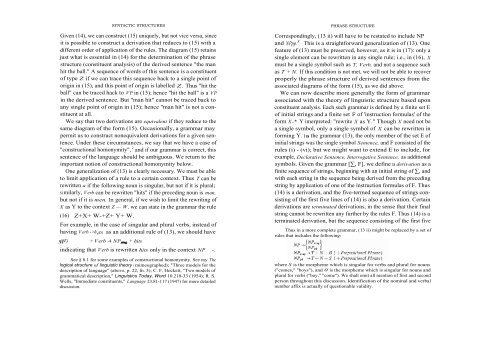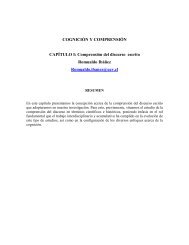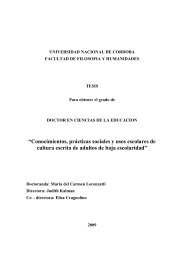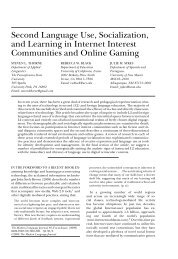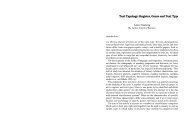Syntactic Structures
Syntactic Structures
Syntactic Structures
You also want an ePaper? Increase the reach of your titles
YUMPU automatically turns print PDFs into web optimized ePapers that Google loves.
SYNTACTIC STRUCTURES<br />
Given (14), we can construct (15) uniquely, but not vice versa, since<br />
it is possible to construct a derivation that reduces to (15) with a<br />
different order of application of the rules. The diagram (15) retains<br />
just what is essential in (14) for the determination of the phrase<br />
structure (constituent analysis) of the derived sentence "the man<br />
hit the ball." A sequence of words of this sentence is a constituent<br />
of type Z if we can trace this sequence back to a single point of<br />
origin in (15), and this point of origin is labelled Z. Thus "hit the<br />
ball" can be traced hack to VP in (15); hence "hit the ball" is a VP<br />
in the derived sentence. But "man hit" cannot be traced back to<br />
any single point of origin in (15); hence "man hit" is not a constituent<br />
at all.<br />
We say that two derivations are equivalent if they reduce to the<br />
same diagram of the form (15). Occasionally, a grammar may<br />
permit us to construct nonequivalent derivations for a given sentence.<br />
Under these circumstances, we say that we have a case of<br />
"constructional homonymity", 2 and if our grammar is correct, this<br />
sentence of the language should be ambiguous. We return to the<br />
important notion of constructional homonymity below.<br />
One generalization of (13) is clearly necessary. We must be able<br />
to limit application of a rule to a certain context. Thus T can be<br />
rewritten a if the following noun is singular, but not if it is plural;<br />
si milarly, Verb can be rewritten "hits" if the preceding noun is man,<br />
but not if it is men. In general, if we wish to limit the rewriting of<br />
X as Y to the context Z — W, we can state in the grammar the rule<br />
(16) Z+X+ W-+Z+ Y+ W.<br />
For example, in the case of singular and plural verbs, instead of<br />
having Verb ->h its as an additional rule of (13), we should have<br />
(17)<br />
+ Verb -4 NPsing + hits<br />
NP sing<br />
indicating that Verb is rewritten hits only in the context NP<br />
See § 8.1 for some examples of constructional homonymity. See my The<br />
logical structure of linguistic theory ( mimeographed); "Three models for the<br />
description of language" (above, p. 22, fn. 3); C. F. Hockett, "Two models of<br />
grammatical description," Linguistics Today, Word 10.210-33 (1954); R. S.<br />
Wells, "Immediate constituents," Language 23.81-117 (1947) for more detailed<br />
discussion.<br />
-.<br />
PHRASE STRUCTURE<br />
Correspondingly, (13 ii) will have to be restated to include NP<br />
and NPpp. 3 This is a straightforward generalization of (13). One<br />
feature of (13) must be preserved, however, as it is in (17): only a<br />
single element can be rewritten in any single rule; i.e., in (16), X<br />
must be a single symbol such as T, Verb, and not a sequence such<br />
as T + N. If this condition is not met, we will not be able to recover<br />
properly the phrase structure of derived sentences from the<br />
associated diagrams of the form (15), as we did above.<br />
We can now describe more generally the form of grammar<br />
associated with the theory of linguistic structure based upon<br />
constituent analysis. Each such grammar is defined by a finite set E<br />
of initial strings and a finite set F of 'instruction formulas' of the<br />
form X-* Y imerpreted: "rewrite X as Y." Though X need not be<br />
a single symbol, only a single symbol of X can be rewritten in<br />
forming Y. I n the grammar (13), the only member of the set E of<br />
initial strings was the single symbol Sentence, and F consisted of the<br />
rules (i) - (vi); but we might want to extend E to include, for<br />
example, Declarative Sentence, Interrogative Sentence, as additional<br />
symbols. Given the grammar [∑, F], we define a derivation as a<br />
finite sequence of strings, beginning with an initial string of ∑, and<br />
with each string in the sequence being derived from the preceding<br />
string by application of one of the instruction formulas of F. Thus<br />
(14) is a derivation, and the five-termed sequence of strings consisting<br />
of the first five lines of (14) is also a derivation. Certain<br />
derivations are terminated derivations, in the sense that their final<br />
string cannot be rewritten any further by the rules F. Thus (14) is a<br />
terminated derivation, but the sequence consisting of the first five<br />
Thus in a more complete grammar, (13 ii) might be replaced by a set of<br />
rules that includes the following:<br />
where S is the morpheme which is singular for verbs and plural for nouns<br />
("comes," "boys"), and 0 is the morpheme which is singular for nouns and<br />
plural for verbs ("boy," "come"). We shall omit all mention of first and second<br />
person throughout this discussion. Identification of the nominal and verbal<br />
number affix is actually of questionable validity.


